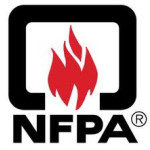- Industry: Fire safety
- Number of terms: 98780
- Number of blossaries: 0
- Company Profile:
Established in 1896, NFPA's mission is to reduce the worldwide burden of fire and other hazards on the quality of life by providing and advocating consensus codes and standards, research, training, and education.
A receptacle strong enough, by reason of material, design, and construction, to be shipped safely without further packaging.
Industry:Fire safety
Dedicated manual or automatic equipment for originating and distributing voice instructions, as well as alert and evacuation signals pertaining to a fire emergency, to the occupants of a building.
Industry:Fire safety
High-frequency energy that can be modulated by voice or signaling impulses.
Industry:Fire safety
High hazard Level 5 contents include hazardous production materials (HPM) used in the fabrication of semiconductors or semiconductor research and development.
Industry:Fire safety
High hazard Level 4 contents include materials that are acute health hazards including, but not limited to, the following: (1) Corrosives (2) Highly toxic materials (3) Toxic materials.
Industry:Fire safety
High hazard Level 3 contents include materials that readily support combustion or present a physical hazard including, but not limited to, the following: (1) Level 2 and Level 3 aerosols (2) Class I, Class II, or Class III-A flammable or combustible liquids that are used or stored in normally closed containers or systems at gauge pressures of less than 15 psi (103. 4 kPa) (3) Classification 1. 4G consumer fireworks (4) Flammable solids, other than dusts classified as high hazard Level 2, stored, used, or generated in a manner creating a high fire hazard (5) Class II and Class III organic peroxides (6) Class 2 solid or liquid oxidizers (7) Class 3 solid or liquid oxidizers that are used or stored in normally closed containers or systems at gauge pressures of less than 15 psi (103. 4 kPa) (8) Oxidizing gases and oxidizing cryogenic liquids (9) Class 2 unstable (reactive) materials (10) Class 2 water-reactive materials.
Industry:Fire safety
High hazard Level 2 contents include materials that present a deflagration hazard or a hazard from accelerated burning including, but not limited to, the following: (1) Class I, Class II, or Class III-A flammable or combustible liquids that are used or stored in normally open containers or systems, or in closed containers or systems at gauge pressures of more than 15 psi (103. 3 kPa) (2) Combustible dusts stored, used, or generated in a manner creating a severe fire or explosion hazard (3) Flammable gases and flammable cryogenic liquids (4) Class I organic peroxides (5) Class 3 solid or liquid oxidizers that are used or stored in normally open containers or systems, or in closed containers or systems at gauge pressures of more than 15 psi (103. 3 kPa) (6) Nondetonable pyrophoric materials (7) Class 3 nondetonable unstable (reactive) materials (8) Class 3 water-reactive materials.
Industry:Fire safety
High hazard Level 1 contents include materials that present a detonation hazard, but not limited to, explosives; unclassified detonable organic peroxides; Class 4 oxidizers; detonable pyrophoric materials ; and unstable (reactive) materials, Class 3 detonable, and Class 4.
Industry:Fire safety
High hazard contents include materials defined as hazardous materials in NFPA 1, whether stored, used or handled.
Industry:Fire safety
